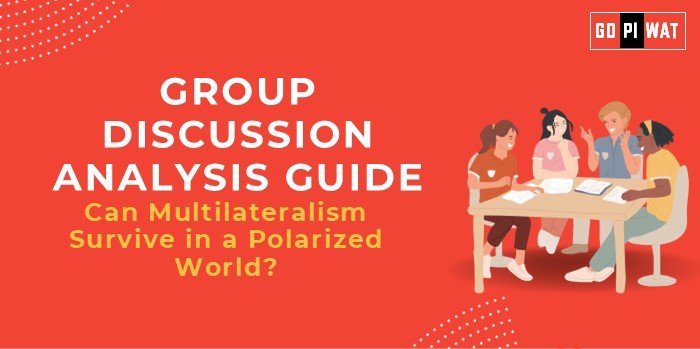📋 Group Discussion (GD) Analysis Guide
🌟 Can Multilateralism Survive in a Polarized World?
🌐 Introduction to the Topic
Opening Context: “In an increasingly divided world marked by political, economic, and ideological polarization, multilateralism faces its greatest test since the formation of global institutions like the UN.”
Topic Background: Multilateralism refers to multiple countries working together on common issues, rooted in post-World War II frameworks. Challenges such as geopolitical rivalries, nationalistic policies, and economic disparities now threaten this collaborative approach.
📊 Quick Facts and Key Statistics
- 🌍 UN Membership: 193 member states, with key initiatives in peacekeeping, development, and human rights.
- 💼 Global Trade Dependency: 60% of global trade relies on multilateral agreements like WTO frameworks (IMF, 2023).
- ⚔️ Conflict Zones: Over 50% of peacekeeping operations are stalled due to geopolitical tensions (UN Report, 2023).
- 📈 Polarization Index: Global political polarization has increased by 30% since 2010 (Pew Research).
👥 Stakeholders and Their Roles
- 🇺🇳 National Governments: Drive or resist multilateral initiatives based on national interests.
- 🌐 Global Institutions (e.g., UN, WTO, IMF): Act as mediators and implementers of multilateral agreements.
- 🏢 Private Sector: Supports global economic frameworks and sustainable development goals.
- 🤝 Civil Society: Advocates for inclusive and people-centered multilateralism.
🏆 Achievements and Challenges
- 🎯 Achievements:
- Paris Agreement (2015): A historic multilateral effort on climate action.
- COVID-19 Vaccination Drive: Coordinated by COVAX, though unevenly distributed.
- SDGs Progress: Reduction in global poverty by 10% since 2000 due to multilateral programs.
- ⚠️ Challenges:
- Geopolitical Rivalries: US-China competition limits cooperation in global governance.
- Rise of Nationalism: Brexit and similar movements undermine collaborative policies.
🌍 Global Comparisons
- 🇪🇺 Success Example: The EU as a successful multilateral model for regional integration.
- 🇺🇳 Challenge Example: UN Security Council’s inefficiency due to veto power misuse.
📋 Structured Arguments for Discussion
- ✔️ Supporting Stance: “Multilateralism remains indispensable for addressing global challenges like climate change and pandemics.”
- ❌ Opposing Stance: “Polarization and national interests make multilateral agreements nearly impossible to sustain.”
- ⚖️ Balanced Perspective: “While multilateralism faces challenges, reform and innovation can revitalize its relevance.”
🛠️ Effective Discussion Approaches
- 🔍 Opening Approaches:
- “From the Paris Agreement to the SDGs, multilateralism has achieved much, but rising polarization now tests its foundations.”
- “The world’s challenges are global, but the solutions are increasingly local—can multilateralism bridge this gap?”
- 💬 Counter-Argument Handling:
- Suggest reforms such as equitable representation in global institutions.
- Propose hybrid models combining multilateralism with regional collaborations.
📈 Strategic Analysis of Strengths and Weaknesses
- 🟢 Strengths: Collective problem-solving; legitimacy through inclusivity.
- 🟡 Weaknesses: Bureaucratic inefficiencies; dominance of powerful nations.
- 🔵 Opportunities: Address emerging global challenges like AI ethics.
- 🔴 Threats: Fragmentation due to geopolitical tensions and unilateral actions.
📚 Connecting with B-School Applications
- 🌏 Real-World Applications:
- Explore multilateral trade frameworks or crisis management models in global supply chains.
- 🤔 Sample Interview Questions:
- “What reforms are needed to make the UN more effective in today’s polarized world?”
- “How can businesses contribute to sustaining multilateral cooperation?”
- 💡 Insights for Students:
- Investigate how multilateral decisions impact international markets and global sustainability initiatives.


